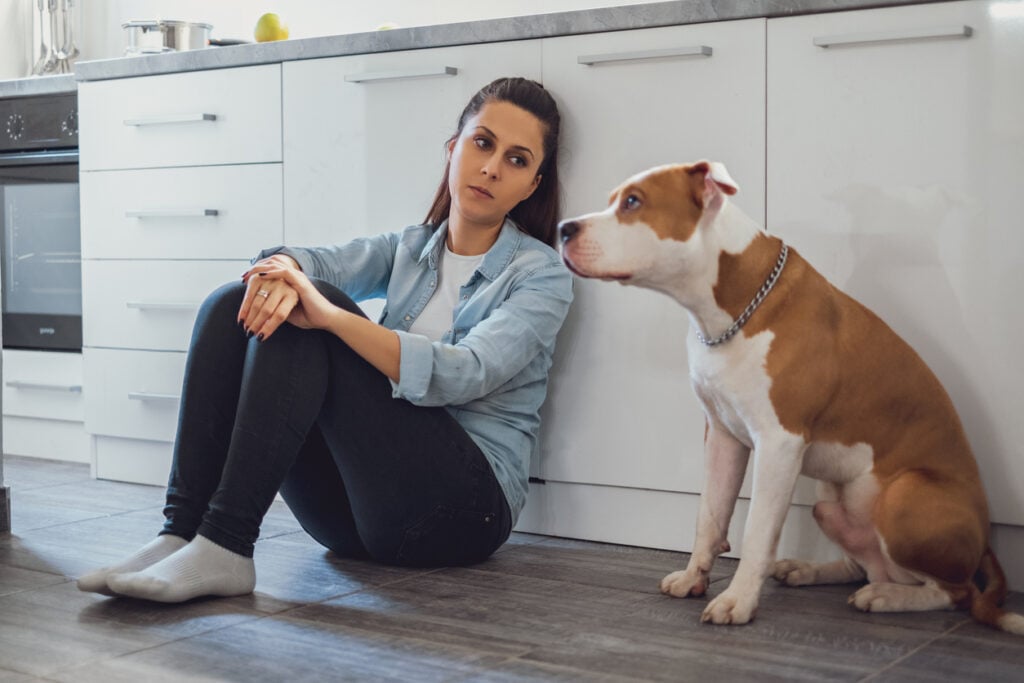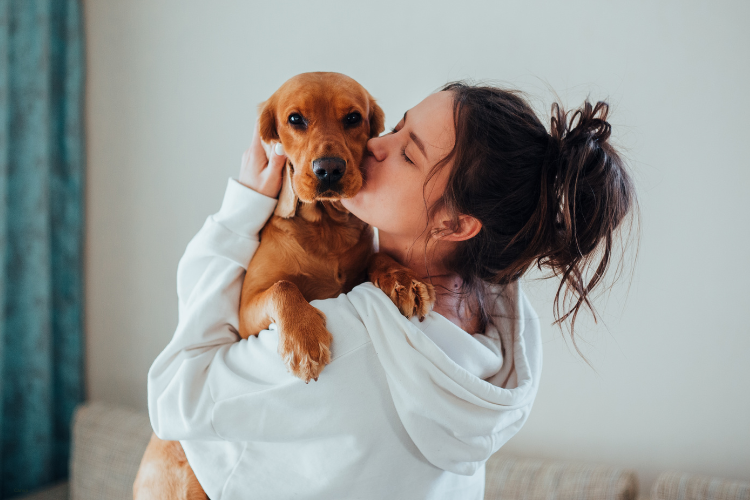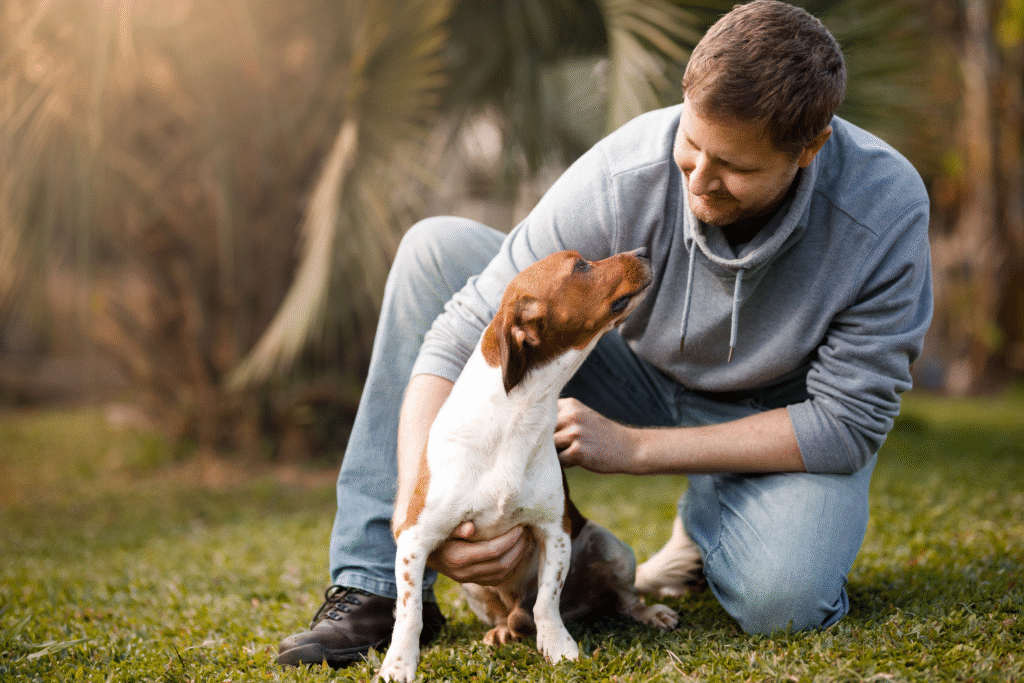Everyday actions that quietly make your dog more nervous.

Dogs learn far more from our behavior than from our words. Every sigh, tone, and habit sends them a message about safety—or danger. Recent studies in veterinary behavior show that owners often pass on their own stress without realizing it, creating anxious, reactive dogs over time. The issue isn’t cruelty, but unawareness. Many of the routines people think are comforting—extra cuddles, quick corrections, inconsistent routines—can actually build tension in a dog’s nervous system. Understanding these small mistakes can help prevent fear and restore calm in the relationship.
1. You mirror your own stress and it rubs off on your dog.

Dogs read our emotional states with remarkable accuracy. Research from the University of Bristol found that dogs mirror their owners’ stress levels through hormonal changes, suggesting a shared emotional link between humans and their pets. If you rush through your day, raise your voice, or react anxiously to small events, your dog absorbs that tension. Over time, they learn that the world is unpredictable and tense. By managing your own stress with calm routines and steady tone, you’re not just helping yourself—you’re teaching your dog emotional stability.
2. Punishment-based training backfires and builds chronic fear, as stated by veterinary behavior experts.

When owners rely on harsh corrections, shouting, or shock collars, the result isn’t obedience—it’s learned anxiety. Veterinary behaviorists from the American Veterinary Society of Animal Behavior (AVSAB) report that punishment-based training increases fear-related behaviors and damages trust. Dogs trained this way often suppress their natural instincts out of worry, not understanding. Over time, this erodes confidence and fosters reactivity. Positive reinforcement, on the other hand, builds reliable behavior through trust and security—without the emotional side effects that fear leaves behind.
3. Ignoring household noises can normalize hidden sources of fear.

Household sounds like vacuums, doorbells, or kitchen appliances may seem trivial, but they’re often powerful stressors. A 2024 University of California study found that over half of dogs display fear or avoidance behaviors toward everyday noises. If you dismiss these reactions, your dog learns that their fear doesn’t matter. Instead, acknowledging and desensitizing them to those sounds teaches safety and resilience. Gradual exposure paired with calm reassurance helps replace fear with familiarity, reducing anxiety over time.
4. Over-protecting your dog prevents them from learning resilience.

Picking your dog up at the first bark or shielding them from strangers might feel loving, but it can quietly teach fragility. By intervening too quickly, you remove their chance to face mild challenges. Without practice, they begin to interpret ordinary life as threatening. The next time they encounter stress alone, they’ll freeze or panic. Teaching calm independence—by allowing safe exploration and gradual exposure—helps build emotional endurance rather than fear-based dependence.
5. Inconsistent daily schedules create confusion and insecurity.

Dogs depend on rhythm to feel safe. When feeding times, walks, and bedtime shift unpredictably, they lose that sense of control. In the absence of routine, cortisol levels can rise, fueling anxiety. A steady schedule doesn’t just make life easier—it communicates stability. Even small adjustments, like keeping walk times consistent, help a dog’s nervous system relax. Consistency tells them, “You can count on me,” and for an anxious dog, that’s the foundation of peace.
6. Mixed signals make your dog uncertain of what’s right.

Dogs thrive on clarity. When you encourage jumping one moment and scold it the next, your dog can’t decode your expectations. This back-and-forth pattern teaches them to anticipate correction rather than connection. It’s not the mistake that confuses them—it’s the inconsistency. Clear boundaries paired with patience build understanding. Emotional steadiness is the difference between a confident dog and one walking on eggshells.
7. Comforting anxious reactions reinforces the fear response.

When your dog trembles or barks and you instantly rush to cuddle them, you might be teaching that fear brings reward. The attention feels comforting, but it confirms the emotion. Instead, staying calm and redirecting with gentle, confident body language models security. Over time, your dog learns that calmness—not panic—earns reassurance. This doesn’t mean ignoring fear, but showing that safety exists even without immediate rescue.
8. Lack of social exposure quietly builds lifelong anxiety.

A dog kept in a small comfort zone never learns that new things can be safe. Missing out on early socialization or variety in adult life makes later experiences—new people, sounds, or places—overwhelming. Controlled, positive exposure early on helps create stability. Every new environment teaches adaptability and shrinks the “fear bubble.” The world stops feeling dangerous when your dog realizes most surprises end in safety.
9. Your emotional tone teaches your dog how to interpret the world.

Dogs understand energy more than words. A high-pitched, worried “It’s okay!” often signals danger rather than calm. Your tone sets the emotional climate in every moment. If you remain neutral and relaxed during stressful events, your dog learns to regulate by example. It’s not what you say—it’s how your body and voice feel when you say it. Calmness is contagious, and your dog’s brain is wired to catch yours.
10. Long periods of isolation deepen attachment-related anxiety.

When dogs spend most of their time waiting for your return, separation becomes unbearable. The longer the loneliness, the more powerful the association between absence and panic. That’s how destructive behaviors and constant barking develop. Counteracting this takes gradual independence training—structured alone time, toys that occupy their focus, and calm departures. When solitude stops being frightening, your dog finally rests, even when you’re not home.
11. Overlooking stress signals causes anxiety to become chronic.

A dog that yawns repeatedly, avoids eye contact, or licks lips during stress is trying to communicate. Ignoring those cues teaches them their signals don’t work, which amplifies internal tension. Over time, the anxiety internalizes, surfacing later as reactivity or aggression. Observing early, subtle signs lets you intervene before stress spirals. Understanding body language isn’t optional—it’s emotional literacy for the relationship you share.
12. Mental boredom turns into nervous energy and worry.

Dogs need jobs, not just walks. Without enrichment, their energy converts into anxiety. Chewing furniture, pacing, or obsessive licking are signs of a mind craving challenge. Enrichment—sniffing games, problem-solving toys, and new routes—releases built-up energy constructively. It reminds your dog that curiosity and calm can coexist. When their brain is engaged, fear doesn’t find room to grow.
